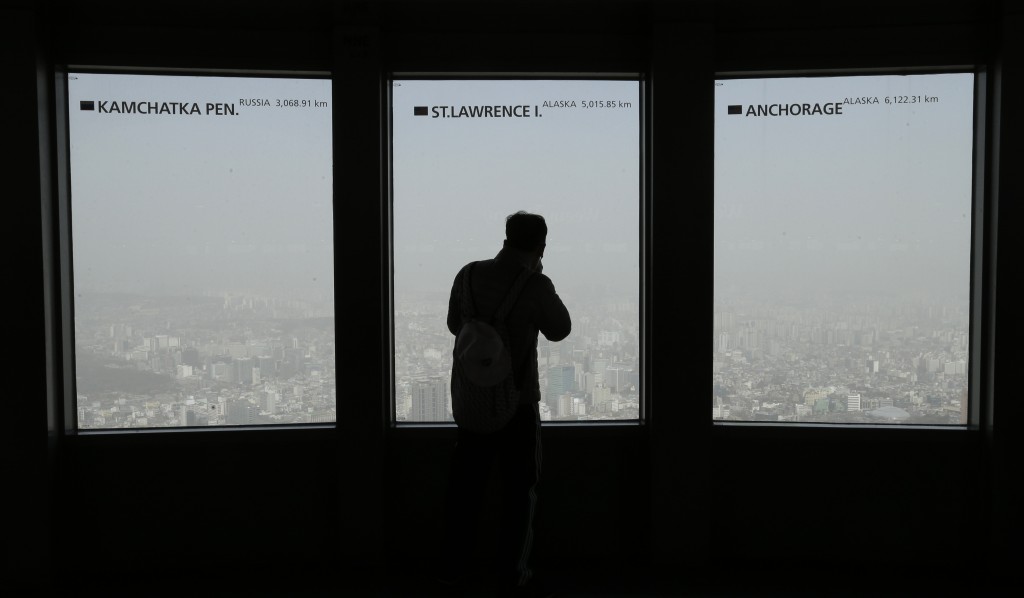- California Assembly OKs highest minimum wage in nation
- S. Korea unveils first graphic cigarette warnings
- US joins with South Korea, Japan in bid to deter North Korea
- LPGA golfer Chun In-gee finally back in action
- S. Korea won’t be top seed in final World Cup qualification round
- US men’s soccer misses 2nd straight Olympics
- US back on track in qualifying with 4-0 win over Guatemala
- High-intensity workout injuries spawn cottage industry
- CDC expands range of Zika mosquitoes into parts of Northeast
- Who knew? ‘The Walking Dead’ is helping families connect
Korea hit by worst winter yellow dust in 5 years

A man watches the city skyline covered with a thick haze caused by yellow dust at Seoul Tower’s observation deck in Seoul, South Korea, Monday, Feb. 23, 2015. The Seoul metropolitan government issued a dust warning, urging people to stay indoors. ( AP Photo/Ahn Young-joon)

Runway lights are lit at Incheon International Airport, west of Seoul, amid a cloud of yellow dust blowing from China on Feb. 23, 2015. (Yonhap)
SEOUL (Yonhap) — The worst winter seasonal yellow dust in five years blanketed the Korean Peninsula on Monday, prompting the authorities to issue health warnings against the sandy, chemical-laden wind from China.
According to the Korea Meteorological Administration (KMA), yellow dust warnings were issued at 10 a.m. in Incheon, Seoul, Gyeonggi Province and part of Gangwon Province with dust advisories in place for most other parts of the peninsula except some southeastern cities, including Busan and Ulsan.
The dust warnings in the capital area were to be lowered to advisories at 4 p.m. as the number of fine dust particles gradually decreased.
A yellow dust advisory is issued when an hourly average dust concentration of more than 400 micrograms per cubic meter is expected to last for more than two hours. More than 800 micrograms leads to a yellow dust warning.
People are advised to stay indoors when yellow dust advisories or warnings are in place. When going outside, they are advised to wear protective glasses and yellow-dust masks.
As of 4 a.m., Seoul’s atmospheric concentration levels of “particulate matter (PM)-10″ pollutants soared to 1,044 micrograms per cubic meter. This marks the worst yellow dust that has hit the peninsula during a winter season since Dec. 25, 2009, when the level recorded 963 micrograms.
PM-10 refers to airborne particles 10 micrometers or less in diameter. Epidemiological evidence indicates that exposure to such pollutants causes cardiac and respiratory problems, according to experts.
This also is the fourth highest level since the authorities began filing records for fine dust concentration.
Yellow dust warnings had previously been in place in Seoul five times — in March 2002, April 2002, April 2006, December 2009 and November 2010.
Monday’s yellow dust was the result of the combination of low precipitation and low pressure in the deserts in southern Mongolia and northern China where the dust mainly originates from as well as a strong northwesterly wind, the KMA said.
The weather office forecast that the yellow dust will gradually weaken starting in the afternoon. Light yellow dust is expected to continue in some areas until Tuesday, it added.
















Pingback: Yellow dust storm carries Chinese pollutants to Korea | BLOUIN BEAT: Science & Health
Pingback: boutique officiel nike
imvu credit hack
August 28, 2017 at 12:46 AM
I am telling that we can have imvu free credits for the imvu account easily so go and get it easily by just on one click.